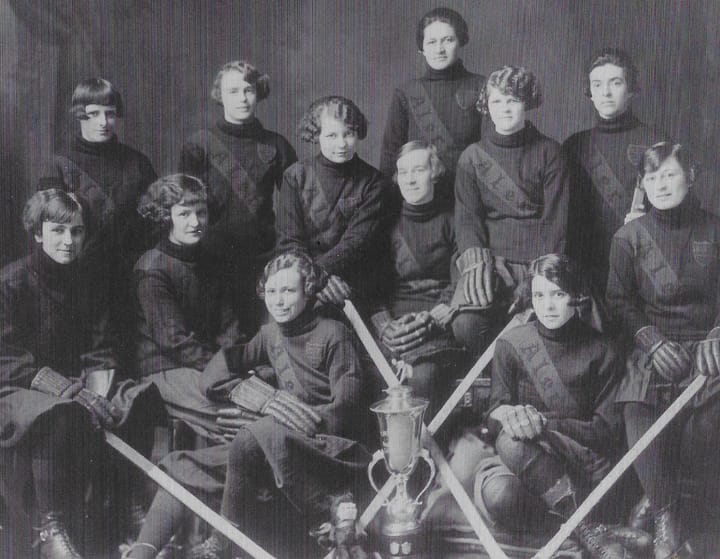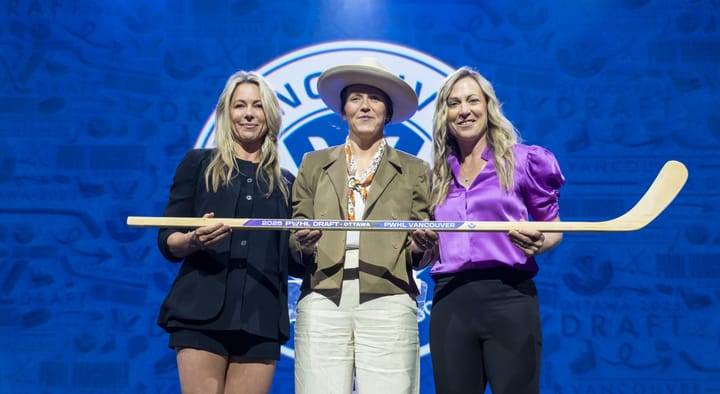Don’t Overthink This. Daryl Watts Should Win The Patty Kaz
She’s the obvious top player in women’s college hockey, and she should be recognized as such.
Thursday afternoon, USA Hockey announced the ten finalists for the Patty Kazmaier Award. You’ve got the usual assortment of elite forwards, two-way defenders, and the top couple goaltenders, but like every year it’s pretty clear who the frontrunner is before the final vote even happens.
This year, that player is Boston College’s Daryl Watts.
Why?
Let’s put it this way: there’s a reason everyone is being compared to Watts this season.
So far a few of the other nominees have had a run as top contender up against Watts, but the real hipster choice over the last couple weeks has been Boston University’s senior forward Victoria Bach.
There’s no doubt about it, Bach is an elite talent and will be sitting alongside Watts at the Patty Kazmaier brunch in Minneapolis next month as one of the final three. But on a head-to-head basis, any suggestion that Bach should win over Watts is just arguing for the sake of arguing.
One of the primary reasons why proponents of Bach – as well as some of the other top players like Clarkson’s Loren Gabel – want to discount Watts’ success this year is because Watts is a freshman. If any voter on the committee chose not to vote for Watts just because of her class year, they would be doing so in ignorance of the award criteria.
Here is the description of the award from the Patty Kazmaier Award website:
The Patty Kazmaier Memorial Award is presented annually to the top player in NCAA Division I women’s ice hockey. Other selection criteria include outstanding individual and team skills, sportsmanship, performance in the clutch, personal character, competitiveness and a love of hockey. Consideration is also given to academic achievement and civic involvement.
This is an award for the nation’s top women’s college hockey player. Hard stop.
#BCEagles trio voted #PattyKaz Top 10 Finalists, an award presented to the national player of the year. FULL INFO: https://t.co/VgrA9hNIGm pic.twitter.com/ONGx4RHYTf
— BC Women's Hockey (@BC_WHockey) February 22, 2018
With a mind-blowing 40 goals, 39 assists, and 79 points in 34 games, Daryl Watts leads all of women’s college hockey in almost every major statistical category. But when you dive into the next level of analyzing her numbers, the gap between her and the field gets even wider. In fact, it starts to look like her closest competition is her own teammate, Caitrin Lonergan, over some of the other options.
One of the best things Watts has going for her over her competition is that her stats have come against a dramatically tougher level of competition than Bach’s. Bach cleaned up against bottom of the barrel teams and inflated those numbers.
Take a look at the numbers Victoria Bach put up against some of the worst teams in college hockey:
4-1--5 against Vermont (25/40 PWR)
4-0--4 against Yale (28/40 PWR)
3-1--4 against Mankato (36/40 PWR)
1-2--3 against RIT (38/40 PWR)
2-3--5 against Brown (39/40 PWR)
That’s a 14-7--21 line in 5 games for BU against terrible teams. Other than Vermont, a league opponent, BC hasn’t played a single team as bad as those other four teams. BU played an embarrassingly soft schedule this year – so much so that a full 1/6th of the games Bach has played in this year have been against teams worse than any team BC has played this season.
It makes sense to expect that Watts, too, might have put up most of her numbers against bad teams. But shocking as it may be, it’s actually the opposite: Daryl Watts put up the bulk of her production against top teams.
Take a look at the comparison of the five forwards named as Patty Kazmaier Award finalists and their production against the Top 20 and Bottom 20 teams in the Pairwise:
Not only is Daryl Watts the only player to come up big in the big games, but Victoria Bach’s production shrinks more drastically than any of the other top forwards when she’s playing real competition. She loses well over a point per game of her scoring.
But okay, forget top versus bottom. What about in conference games, the games in which Bach and Watts share equal competition? Watts continues to dunk on Bach statistically, putting up a 30-25—55 line in 24 games, maintaining her consistent production at a 2.29 PPG clip. Bach’s numbers shrink considerably, at 21-17—38 in 22 games, for 1.73 PPG.
Let’s get an even closer comparison than that – head-to-head matchups. Victoria Bach practically disappeared in games against her cross-town rival, going just 1-5—6 in four games. Compare that to Watts, who exploded for a whopping 7-3—10 in those same four games. Among those? Two game-winning assists and a mammoth game-tying goal late in the third period of the Beanpot, which allowed BC to claim the trophy in overtime – talk about “performance in the clutch.”
No Doubt About It
Yes, it is unprecedented for a freshman to win the award, but Daryl Watts’ season has been no ordinary rookie campaign. She’s put up generational numbers which have only been topped by the sport’s legends. The only Patty Kazmaier Award winners to top Watts’ current 2.32 PPG pace in an NCAA season were Jennifer Botterill’s 3.50 PPG in ’02-’03, Amanda Kessel’s 2.73 PPG in ’12-’13, and Krissy Wendell’s 2.60 PPG in ’04-’05. These aren’t top freshman numbers – these are top all time numbers.
It seems incredible that anyone should have to say all this, because Daryl Watts’ staggering season should speak for itself. But there can be no doubt that her Eagles, currently sitting at #2 in the Pairwise heading into conference play, would not be ranked even close to where they are now if Watts didn’t matriculate at Boston College this year.
This is a very easy vote for the selection committee. The Patty Kazmaier Memorial Award is presented annually to the top player in NCAA Division I women’s ice hockey.
Daryl Watts is that player.
Daryl Watts should win the award.





Comments ()